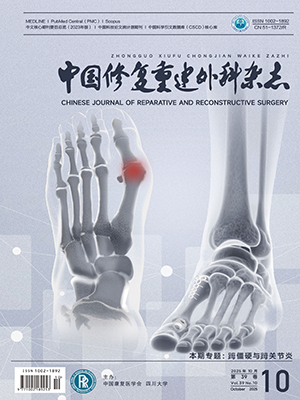| 1. |
Yam M, Chawla A, Kwek E. Rewriting the tip apex distance for the proximal femoral nail anti-rotation. Injury, 2017, 48(8): 1843-1847.
|
| 2. |
?zdemir E, Okkaoglu MC, Evren AT, et al. The cost and consequences of failed osteosynthesis of intertrochanteric femur fractures: A matched cohort study. Indian J Orthop, 2021, 55(3): 629-635.
|
| 3. |
Stern LC, Gorczyca JT, Kates S, et al. Radiographic review of helical blade versus lag screw fixation for cephalomedullary nailing of low-energy peritrochanteric femur fractures: there is a difference in cutout. J Orthop Trauma, 2017, 31(6): 305-310.
|
| 4. |
Nikoloski AN, Osbrough AL, Yates PJ. Should the tip-apex distance (TAD) rule be modified for the proximal femoral nail antirotation (PFNA)? A retrospective study. J Orthop Surg Res, 2013, 8: 35.
|
| 5. |
Kaufer H. Mechanics of the treatment of hip injuries. Clin Orthop Relat Res, 1980, (146): 53-61.
|
| 6. |
Cleveland M, Bosworth DM, Thompson FR, et al. A ten-year analysis of intertrochanteric fractures of the femur. J Bone Joint Surg (Am), 1959, 41-A: 1399-1408.
|
| 7. |
喬文, 呂欣, 劉晉元, 等. 有限元評估尖頂距與股距尖頂距對股骨轉子間骨折髓內釘內固定術后穩定性的影響. 中國組織工程研究, 2020, 24(36): 5755-5763.
|
| 8. |
Baumgaertner MR, Curtin SL, Lindskog DM, et al. The value of the tip-apex distance in predicting failure of fixation of peritrochanteric fractures of the hip. J Bone Joint Surg (Am), 1995, 77(7): 1058-1064.
|
| 9. |
Kane P, Vopat B, Heard W, et al. Is tip apex distance as important as we think? A biomechanical study examining optimal lag screw placement. Clin Orthop Relat Res, 2014, 472(8): 2492-2498.
|
| 10. |
Goffin JM, Pankaj P, Simpson AH. The importance of lag screw position for the stabilization of trochanteric fractures with a sliding hip screw: a subject-specific finite element study. J Orthop Res, 2013, 31(4): 596-600.
|
| 11. |
Liu W, Zhou D, Liu F, et al. Mechanical complications of intertrochanteric hip fractures treated with trochanteric femoral nails. J Trauma Acute Care Surg, 2013, 75(2): 304-310.
|
| 12. |
Aguado-Maestro I, Escudero-Marcos R, García-García JM, et al. Results and complications of pertrochanteric hip fractures using an intramedullary nail with a helical blade (proximal femoral nail antirotation) in 200 patients. Rev Esp Cir Ortop Traumatol, 2013, 57(3): 201-207.
|
| 13. |
Caruso G, Corradi N, Caldaria A, et al. New tip-apex distance and calcar-referenced tip-apex distance cut-offs may be the best predictors for cut-out risk after intramedullary fixation of proximal femur fractures. Sci Rep, 2022, 12(1): 357.
|
| 14. |
Turgut A, Kalenderer ?, Karap?nar L, et al. Which factor is most important for occurrence of cutout complications in patients treated with proximal femoral nail antirotation? Retrospective analysis of 298 patients. Arch Orthop Trauma Surg, 2016, 136(5): 623-630.
|
| 15. |
Karap?nar L, Turgut A, Kumbarac? M, et al. Evaluation of the quadrants of femoral neck-head in the cephalomedullary fixation of intertrochanteric fractures with a helical blade: Is inferior posterior quadrant also safe? A clinical study. Jt Dis Relat Surg, 2021, 32(1): 93-100.
|
| 16. |
Kuzyk PR, Zdero R, Shah S, et al. Femoral head lag screw position for cephalomedullary nails: a biomechanical analysis. J Orthop Trauma, 2012, 26(7): 414-421.
|
| 17. |
Parker MJ. Cutting-out of the dynamic hip screw related to its position. J Bone Joint Surg (Br), 1992, 74(4): 625.
|
| 18. |
Murena L, Moretti A, Meo F, et al. Predictors of cut-out after cephalomedullary nail fixation of pertrochanteric fractures: a retrospective study of 813 patients. Arch Orthop Trauma Surg, 2018, 138(3): 351-359.
|
| 19. |
Kashigar A, Vincent A, Gunton MJ, et al. Predictors of failure for cephalomedullary nailing of proximal femoral fractures. Bone Joint J, 2014, 96-B(8): 1029-1034.
|
| 20. |
Ibrahim I, Appleton PT, Wixted JJ, et al. Implant cut-out following cephalomedullary nailing of intertrochanteric femur fractures: Are helical blades to blame? Injury, 2019, 50(4): 926-930.
|
| 21. |
Huang JW, Gao XS, Yang YF. Risk factors for cut-outs in geriatric intertrochanteric fractures with cephalomedullary nailing after obtaining acceptable reduction: a case-control study. BMC Musculoskelet Disord, 2022, 23(1): 354.
|
| 22. |
Baumgaertner MR, Solberg BD. Awareness of tip-apex distance reduces failure of fixation of trochanteric fractures of the hip. J Bone Joint Surg (Br), 1997, 79(6): 969-971.
|
| 23. |
Haidukewych GJ. Intertrochanteric fractures: ten tips to improve results. J Bone Joint Surg (Am), 2009, 91(3): 712-719.
|
| 24. |
Güven M, Yavuz U, Kadio?lu B, et al. Importance of screw position in intertrochanteric femoral fractures treated by dynamic hip screw. Orthop Traumatol Surg Res, 2010, 96(1): 21-27.
|
| 25. |
De Bruijn K, den Hartog D, Tuinebreijer W, et al. Reliability of predictors for screw cutout in intertrochanteric hip fractures. J Bone Joint Surg (Am), 2012, 94(14): 1266-1272.
|
| 26. |
Rubio-Avila J, Madden K, Simunovic N, et al. Tip to apex distance in femoral intertrochanteric fractures: a systematic review. J Orthop Sci, 2013, 18(4): 592-598.
|
| 27. |
蔡群斌, 鄒霞, 胡劍濤, 等. 有限元法分析尖頂距與股骨近端防旋髓內釘固定股骨轉子間骨折穩定性的關系. 中國組織工程研究, 2021, 25(6): 831-836.
|
| 28. |
Khanna V, Tiwari M. Significance of tip apex distance in intertrochanteric fracture femur managed with proximal femoral nailing. Orthop Traumatol Surg Res, 2021, 107(6): 103009.
|
| 29. |
Herman A, Landau Y, Gutman G, et al. Radiological evaluation of intertrochanteric fracture fixation by the proximal femoral nail. Injury, 2012, 43(6): 856-863.
|
| 30. |
吳歡. InterTan治療股骨轉子間骨折TAD測量方法的比較研究. 大連: 大連醫科大學, 2013.
|
| 31. |
Nüchtern JV, Ruecker AH, Sellenschloh K, et al. Malpositioning of the lag screws by 1- or 2-screw nailing systems for pertrochanteric femoral fractures: a biomechanical comparison of gamma 3 and intertan. J Orthop Trauma, 2014, 28(5): 276-282.
|
| 32. |
中國脆性骨折聯盟, 中國老年醫學學會骨與關節分會創傷骨科學術工作委員會, 白求恩·骨科加速康復聯盟, 等. 老年股骨轉子間骨折診療指南. 中華創傷骨科雜志, 2020, 22(2): 93-99.
|
| 33. |
Caruso G, Bonomo M, Valpiani G, et al. A six-year retrospective analysis of cut-out risk predictors in cephalomedullary nailing for pertrochanteric fractures: Can the tip-apex distance (TAD) still be considered the best parameter? Bone Joint Res, 2017, 6(8): 481-488.
|
| 34. |
Li S, Chang SM, Jin YM, et al. A mathematical simulation of the tip-apex distance and the calcar-referenced tip-apex distance for intertrochanteric fractures reduced with lag screws. Injury, 2016, 47(6): 1302-1308.
|
| 35. |
Subasi O, Aslan L, Demirhan M, et al. A novel lower bound for tip-apex distance. Eur J Trauma Emerg Surg, 2022, 48(3): 1787-1798.
|
| 36. |
Goffin JM, Jenkins PJ, Ramaesh R, et al. What is the relevance of the tip-apex distance as a predictor of lag screw cut-out? PLoS One, 2013, 8(8): e71195.
|
| 37. |
Born CT, Karich B, Bauer C, et al. Hip screw migration testing: first results for hip screws and helical blades utilizing a new oscillating test method. J Orthop Res, 2011, 29(5): 760-766.
|
| 38. |
Flores SA, Woolridge A, Caroom C, et al. The utility of the tip-apex distance in predicting axial migration and cutout with the trochanteric fixation nail system helical blade. J Orthop Trauma, 2016, 30(6): e207-e211.
|
| 39. |
Raghuraman R, Kam JW, Chua DTC. Predictors of failure following fixation of intertrochanteric fractures with proximal femoral nail antirotation. Singapore Med J, 2019, 60(9): 463-467.
|
| 40. |
Lopes-Coutinho L, Dias-Carvalho A, Esteves N, et al. Traditional distance “tip-apex” vs. new calcar referenced “tip-apex”-which one is the best peritrochanteric osteosynthesis failure predictor? Injury, 2020, 51(3): 674-677.
|
| 41. |
Yang YF, Huang JW, Gao XS. CalTAD is the key evaluation tool for measurement of cephalic fixation position for predicting cut-out in geriatric intertrochanteric fracture patients with internal fixations after achieving acceptable reduction. Geriatr Orthop Surg Rehabil, 2022, 13: 21514593221083820.
|
| 42. |
Puthezhath K, Jayaprakash C. Is calcar referenced tip-apex distance a better predicting factor for cutting out in biaxial cephalomedullary nails than tip-apex distance? J Orthop Surg (Hong Kong), 2017, 25(3): 2309499017727920.
|
| 43. |
蔡雨衛, 馮俊濤, 陳羽, 等. 尖頂距與股距尖頂距對亞洲型股骨近端髓內釘內固定治療股骨轉子間骨折術后并發癥的預測價值比較. 中國修復重建外科雜志, 2020, 34(11): 1359-1363.
|
| 44. |
席俊偉, 耿洋, 高山, 等. 骨距頂尖距預測股骨近端髓內釘固定粗隆間骨折的意義. 中國矯形外科雜志, 2021, 29(10): 890-894.
|
| 45. |
Mao W, He YQ, Tang H, et al. A novel angle on helical blade placement in trochanteric fractures—The axis-blade angle. Injury, 2019, 50(7): 1333-1338.
|
| 46. |
Yang AL, Mao W, Chang SM, et al. Computational evaluation of the axis-blade angle for measurements of implant positions in trochanteric hip fractures: A finite element analysis. Comput Biol Med, 2023, 158: 106830.
|
| 47. |
?epni ?, Suba?? ??, ?ahin A, et al. Tip-neck distance ratio as a novel predictor for failure in cephalomedullary nailing of unstable trochanteric fractures (UTF). Arch Orthop Trauma Surg, 2022, 142(10): 2619-2626.
|
| 48. |
Yang YF, Huang JW, Gao XS, et al. Standardized Tip-Apex Distance (STAD): a modified individualized measurement of cephalic fixator position based on its own femoral head diameter in geriatric intertrochanteric fractures with internal fixation. BMC Musculoskelet Disord, 2023, 24(1): 189.
|




